This booklet is 62 pages of knitted and crocheted patterns, published by the Corticelli Silk Mills of Florence, Massachusetts. The copyright is 1917 and is attributed to Nonotuck Silk Company.
Corticelli was into “olas.” Its floss yarn was Flosola. Its fingering yarn was Knitola. Its angora was Angola. And there’s also “Tezola.” It’s “far superior and quite different from the many so-called Teazle yarns on the market. When brushed up it does not have a shaggy appearance.” Oh. Instead, it has a “long, thick nap similar to Angora fur.” It has a “soft, full, loose twist, and will knit up into a much handsomer looking garment than any other Teazle wool.”
Teazle is actually a genus of tall plants that dry to a prickly tough compact head with protruding small spines. One plant, the Fuller’s Teazle, was often used in the textile industry of earlier times to comb out, clean and raise the nap on fabrics, especially wool. So, apparently these “so-called Teazle yarns” were meant to be brushed into fluffiness. Who knew? Thanks to my co-worker’s husband’s Great Aunt Cecilia, I am learning about knitting in the World War I era.
Corticelli offers this advice for washing wool garments:
Wash in tepid water in which pure white soap has been dissolved. Do not rub but knead and squeeze the garment between the hands. Do not at any time raise the garment above the water as the weight of the water tends to stretch the wool. When perfectly clean lower a pillow slip into the water, push in the garment and hang on the line where it wil be exposed to the sun and high wind. Change the pinning of the slip every hour until the garment is thoroughly dry, then remove the garment, shake thoroughly and leave it in the wind for fifteen minutes. It will then look like new and retain all its original loft. Do not press.
Yipes. Washing a garment was basically an all-day task.
The booklet contains patterns for all ages, mostly sweaters, vests, caps, and gloves. Mrs. Vernon Castle models “Sports Vest No. 512,” knitted in Teazola. FYI the photo shows a fabric that definitely looks very shaggy. But Mrs. Castle likes the finished project. She advises that “for motoring, golf or mountain resort, this Sports Vest is ideal” and her “opinion on matters of this kind is always le dernier cri.” (Google translates that phrase as “the latest.”) We are informed that “Mrs. Vernon Castle’s taste in dress is exquisite.”
Here’s a sample–a snazzy looking vest and a buodoir jacket (but not modeled by Mrs. Vernon Castle):
World War I would wage on for two more years after publication of this pattern book. There are some specialty items included, apropos of the era. Consider the “Swagger Cane with Silk Bag Crocheted in National Colors.” This is “not a walking stick, but a swagger cane to carry jauntily under the arm. It holds a little red, white and blue silk bag that testifies to the patriotism of the owner.” Wow. A “swagger cane.”
The last four pages provide patterns for “Knit Garments for the Army and Navy.” The author explains the need:
The following instructions are issued to help the women throughout the country who are at this time utilizing every available moment in making warm and comfortable garments for the boys who have responded to the call of our country in its present crisis. Many women, while anxious to help, are wholly at sea as to what garments are suitable or how best to make them, and much good material and time have been wasted in making garments that are wholly unfit for the service for which they were intended.
Knitters are told to knit “evenly and firmly.” “Drop stitches should be avoided.” “The garments should be free from lumps and knots, especially the socks, as they are liable to blister the feet.” Patterns are included for a sleeveless sweater, two kinds of wristlets, a “sleeping cap,” “muffler,” “cap for convalescents,” an “abdominal belt,” socks, bed socks, knee caps, and a helmet liner that continues on to include front and back garter stitch extensions that would act as a neck warmer.
The price? Fifteen cents.



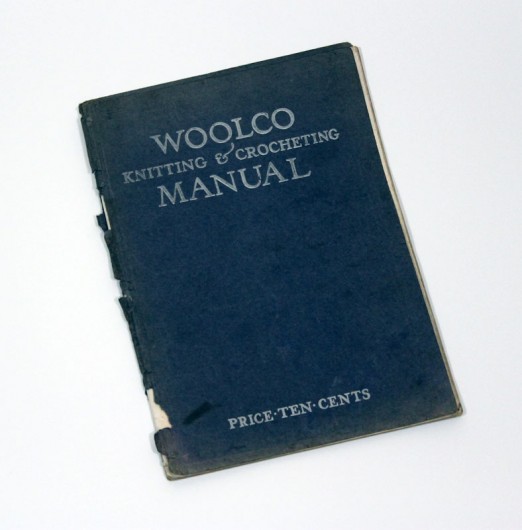





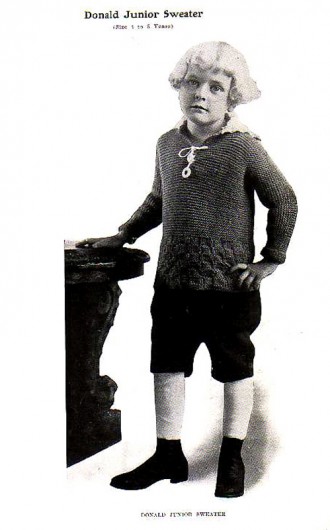 This, from another 1917 knitting booklet. The leggings look like bandages. The shoes seem to be dress shoes, not fit for play. Same for the shorts. His sweater is the only comfortable piece of clothing poor Donald Jr. was allowed to wear that day. And what of the expression on his face? Bored? When the photo shoot was over did he rip that sweater off and head on to a life of privilege. Or something else?
This, from another 1917 knitting booklet. The leggings look like bandages. The shoes seem to be dress shoes, not fit for play. Same for the shorts. His sweater is the only comfortable piece of clothing poor Donald Jr. was allowed to wear that day. And what of the expression on his face? Bored? When the photo shoot was over did he rip that sweater off and head on to a life of privilege. Or something else?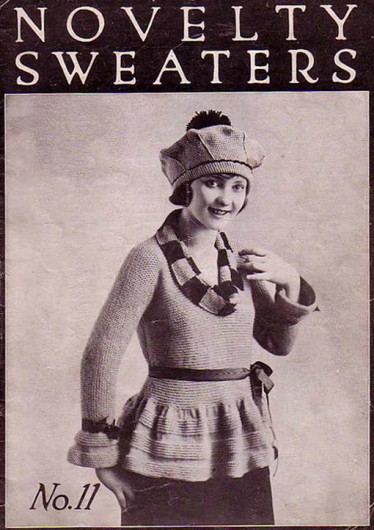
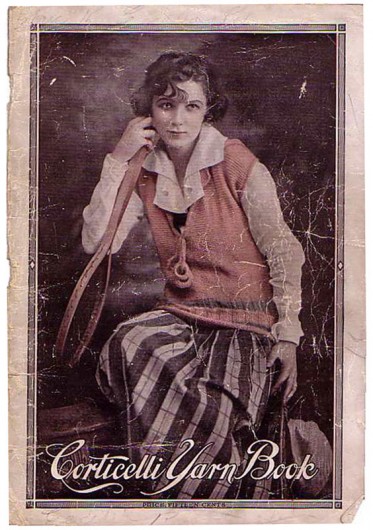
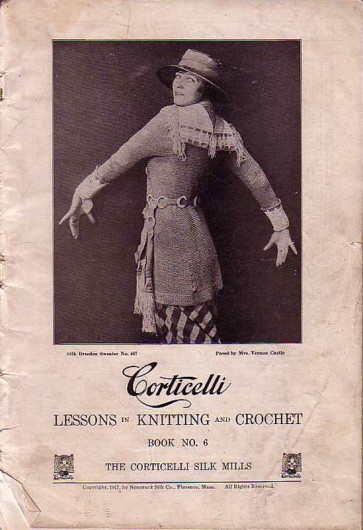
 It was 1917. The Corticelli Yarn Book, “Lessons in Knitting and Crochet” published by the Corticelli Silk Mills in Florence, Massachusetts provided “instructions to help the women throughout the country who are at this time utilizing every available moment in the making of warm and comfortable garments for the boys who have responded to the call of our country in its present crises.” Women were cautioned to knit in either “gray (Oxford) or khaki” or “light Oxford” for the Navy. Corticelli supplied patterns for a sleeveless sweater (above), a “sleeping cap,” two different wristlets, a muffler, an “abdominal belt,” a “cap for convalescents,” a cap and scarf set, socks, bedsocks and a helmet liner (below). A “comfort set” would be the sleeveless sweater, wristlets and a muffler (scarf). “The knitting should be done evenly and firmly and drop stitches should be avoided. The stitches should not be cast on too tightly. The garments should be free from lumps and knots, especially the socks, as they are liable to blister the feet.”
It was 1917. The Corticelli Yarn Book, “Lessons in Knitting and Crochet” published by the Corticelli Silk Mills in Florence, Massachusetts provided “instructions to help the women throughout the country who are at this time utilizing every available moment in the making of warm and comfortable garments for the boys who have responded to the call of our country in its present crises.” Women were cautioned to knit in either “gray (Oxford) or khaki” or “light Oxford” for the Navy. Corticelli supplied patterns for a sleeveless sweater (above), a “sleeping cap,” two different wristlets, a muffler, an “abdominal belt,” a “cap for convalescents,” a cap and scarf set, socks, bedsocks and a helmet liner (below). A “comfort set” would be the sleeveless sweater, wristlets and a muffler (scarf). “The knitting should be done evenly and firmly and drop stitches should be avoided. The stitches should not be cast on too tightly. The garments should be free from lumps and knots, especially the socks, as they are liable to blister the feet.”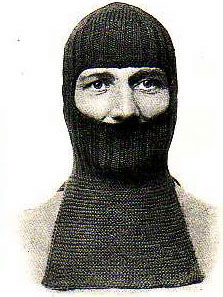 Today,
Today, 